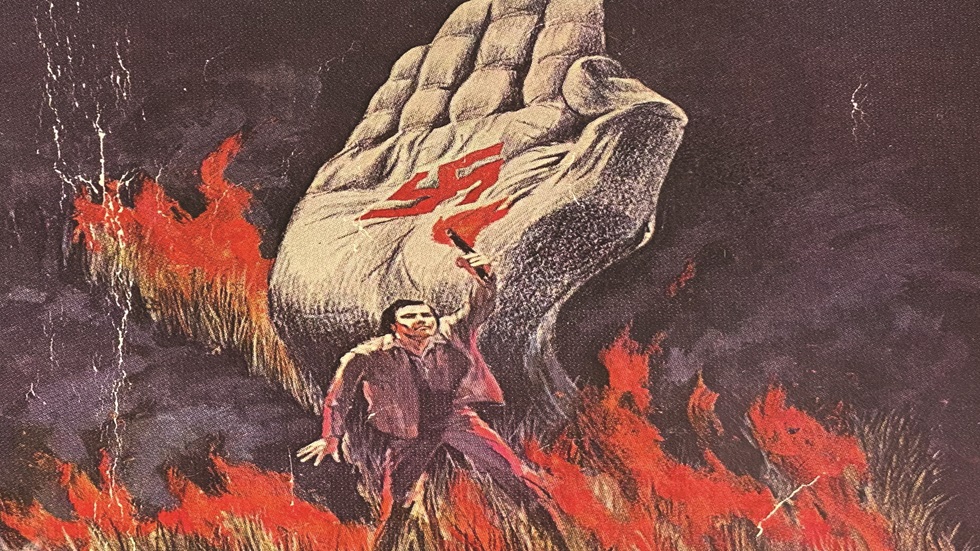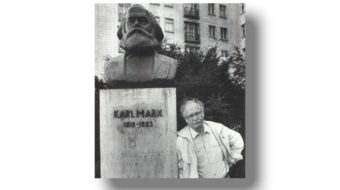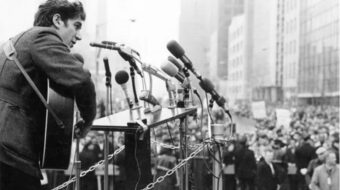
Albert Maltz was born in Brooklyn in 1908, the son of Jewish immigrants from Eastern Europe. As a three-year-old, he witnessed an anti-Semitic attack against his father and older brothers in the street outside their home. He never forgot the incident and said that it made him sensitive to injustice.
Later in his childhood Maltz was inspired by real and imaginary family stories about brave outsiders who fought back against bigotry. In adolescence, he became passionate about boxing because of his father’s belief that “a Jew must learn to fight.”
As a teenager, Maltz was more athlete than scholar, but his fear of failure made him a good student. He showed enough promise at Brooklyn’s Erasmus High School to be admitted to Columbia, where he majored in philosophy. He loved tennis and swimming and trained as a Golden Gloves pugilist, but the first time he got a B on a philosophy exam, he quit all sports. With a professor he worshiped, he studied Plato, Aristotle, and Santayana, taking course after course, searching for the truths of life. He felt as though he’d come to a well and was thirsty, and all he had to do was drink.
In his free time at Columbia, he attended plays and dabbled in the art of the short story. Gradually a goal dawned on him: a writing career that would use what he’d learned about philosophy as a tool to fight evil and celebrate humanity’s search for meaning through moral action.
The Cross and the Arrow, published in 1944, is Albert Maltz’s masterpiece and the fulfillment of that ambition. Long out of print, the novel is being re-released by Alma Books as part of its important “Rediscovering Albert Maltz” project.
Civil disobedience
Set in a village in Nazi Germany, the book explores the psychology of Willi Wegler, a humble industrial laborer, 42 years old, whose wife and son have been killed in Hitler’s war. Though Wegler is decorated with a German service cross, he is inwardly sickened by both Hitler’s genocide and the complicity of his fellow citizens in Third Reich brutalities. Wracked with guilt, Wegler suddenly betrays his country in a stunning gesture of protest and self-sacrifice: While an air raid is going on, he fashions an enormous arrow out of hay in an open field, then ignites it as a flaming signal to direct British bombers to the site of the camouflaged tank factory where he works.
The novel opens at the precise moment of the protagonist’s complex heroism. At 11 p.m. on an August night in 1942, with British bombers thundering overhead, Wegler, “a German citizen of German parents,” touches match to hay and justifies his existence. By 1 a.m. the antifascist resister lies in the factory hospital, near death from a gory abdomen wound inflicted when his seditious act was interrupted by a Schutzstaffel (SS) patrol. There is no possibility of his recovery.
The book’s action takes place over the next twelve hours, during which Wegler drifts in and out of consciousness, pretending he is comatose to thwart his would-be interrogators. While his life passes before him in vivid flashbacks, the world is frantic with an investigation into his treason and with hurried preparations for the renewed bombing raid that must now be anticipated.
Maltz is deeply interested in the motives of Wegler’s civil disobedience, and its long foreground in factors personal and political. What is the breaking point of a conscience? Whence the willpower to turn insurgent?
A nation corrupted
In his youth, Wegler had served Germany bravely in the trenches of the Great War, then married and became a father. To his working-class comrades, he seemed “a quiet man, seemingly decent toward others.” When Hitler was made Chancellor in 1933, he took a concerned attitude of “wait and see.” He didn’t like the new words like “Aryan” and “racial purity” that more and more people were using, or the stories he’d heard about Jews being arrested. Against fascism, he made no overt protest because he felt it would be useless.
Willi’s son Richard was almost fifteen when Hitler came to power. Two years later the boy had become an indoctrinated Hitler youth. Soon after the invasion of Poland, he died a soldier’s death for Führer and Fatherland during a parachute raid in Norway. And when British bombs rained on Düsseldorf in 1941, Willi helped dig the bodies out, including the lifeless body of his wife Kathe.
His family gone, Willi trammeled his grief by seeking oblivion. When the call went out in his factory for a volunteer to replace the “drop-forge man,” the operator of a punishing steam hammer that sooner or later conquered the human who worked it, Wegler stepped forward, in effect choosing a slow suicide.
By accident, Willi met Berthe Lingg, 36 years old and the widow of a farmer, who restored his desire to live and became his fiancée. But the poison of Nazism spoiled even this idyllic relationship. Berthe’s son Rudi returned on military leave bearing gifts for his mother: a sweater, nightgowns, perfume, all stolen from a Frenchwoman Rudi had raped and murdered in Paris. The fact that the young man felt proud of these acts and that Berthe accepted the gifts knowing how they were acquired, convinced Willi that the “rottenness” in the German people was universal.
The matter was compounded when Berthe, pregnant with Willi’s child, “purchased” at auction a Polish war prisoner to work as a slave on her farm. Wegler couldn’t believe it: “You bought a man, Berthe? You paid money for a man?” Suddenly the lovers became strangers, hiding their hearts from one another.
The War Service Cross, awarded to Wegler for exemplary devotion to the Fatherland, was the final straw. With its conferral, Willi was himself dehumanized—nothing more than a stage prop in SS political theater. At the apex of his anti-Nazi hatred, he came to a stark realization: “He too was guilty, and no less guilty than all the rest.”
Everyman and enigma
Now Willi Wegler gropes creatively toward an elemental gesture of protest. His spectacular revolt prompts general amazement. “Who is Wegler, what is he? Why him? What sort of man?” A host of characters seek to resolve the paradox of a life now symbolized by a cross of service and an arrow of sedition.
Julius Baumer, a Nazi functionary and the Labor Front leader of the factory, is stupefied. As the man responsible for decorating Wegler on the day before his treason, he realizes that Wegler’s story will bear on his own fate and is desperate to interrogate him. Adolf Kehr, Gestapo commissar, can do no more than rationalize a diagnosis of sudden insanity, “brain fever,” and stubbornly cling to it.
These men are unequipped to penetrate the enigma, but two onlookers interpret Wegler at a deeper level. Both are political dissenters who’ve been traumatized by fascism, with scars to show for it.
The man in charge of keeping Wegler alive long enough to answer Baumer’s questions is Herman Zoder, 55, the factory physician. He has hated the Hitler movement from its inception, though at first, he believed it could never succeed. Witnessing the acquiescence of the German nation to the Nazi program has left him disillusioned and cynical. For his early inaction he “felt like scum.”
Of Zoder’s mental state, Maltz writes, “When a good man, who has believed in the goodness of other men, comes to experience—and to acknowledge fully to himself—the depths of depravity and cruelty, of viciousness and animalism, of which corrupted men are capable, his revulsion is catastrophic.”
Zoder is effectively paralyzed by what Maltz describes as “a gigantic, consuming hatred” for his own people. His convictions are expressed in a recurring fantasy of a great plague on the Third Reich, after which he will personally count “every last corpse until it was certain that every last German had died. And then he, too, would die for he, too, was a German.”
Vansittartism
The doctor’s view of Germans as inherently wicked represents an ethical controversy that interested Albert Maltz. In the 1940s, the fact that the nation accepted the crimes of the Nazi war machine gave rise to an international debate. Baron Robert Vansittart, a British diplomat, famously espoused a theory (which became known as Vansittartism) that Germany was addicted to war and predisposed to follow murderous authoritarians. Vansittart proposed forcing the German people to comply with a program that would re-educate them. If this program failed, their extermination as a race would be warranted.
Though Zoder’s opinions epitomize Vansittartism, he is perplexed by Wegler, who “could not be hated as he hated other Germans.” To resolve this contradiction, he seeks out Pastor Frisch, who served two years in a prison camp for defending his Lutheran faith against Nazi censorship. He now works in the tank factory’s machine plant. The closing section of The Cross and the Arrow, “The Vision of Jakob Frisch,” is dominated by a debate between Zoder and Frisch over the significance of Wegler’s life.
The moral future
Frisch is the single character capable of translating Wegler’s bravery into meaning. For him, that there’s even one noble man in Germany portends a post-war, post-Hitler cleansing and rebirth. Opposing Zoder, Frisch in effect becomes the spokesman for Albert Maltz’s opinions when thinking of Wegler, he declares, “In his deed, I see the moral future!”
At this moment, having freed himself through principled action, Wegler is ready to die; he struggles to live only long enough to know whether his signal to the British bombers had produced its intended result: “Had the British pilots seen the arrow? He wanted to know!”
Readers of this compelling novel will also want to know. Without spoiling the ending, it can be revealed that at least one man fully understands Willi’s signal. That man vows to use the story of Wegler’s mutiny to foment underground resistance to fascism. And so the moral future is born.
Among the many messages of The Cross and the Arrow is a refutation of the deterministic beliefs of the English baron—an assertion that Vansittartism is not a theory about race, but a racist theory. “As a matter of principle,” Maltz explained late in his life in interviews with biographer Jack Salzman, “I could not accept a racist judgment about any people.”
Maltz also wanted the novel to send messages about the racist history of the United States. He hoped the emphasis given to Third Reich chattel slaves in Wegler’s awakening would prompt stateside readers to compare the Nazi system with America’s own apartheid. Progressives like Maltz were keenly aware, for example, that Hitler studied and admired the racial terrors of the Jim Crow South, and that in significant ways it was Birmingham that taught Berlin.
Abjuring simple formulas to instead deal profoundly with central issues of humanity, Albert Maltz produced an absorbing, intensely dramatic philosophical novel about the soul of man—its ghastly corruption and its capacity for redemption. The “motor power” of the story, Maltz asserted, “is supplied by a moral quest.”
A New Stature
Upon its release in 1944 critics universally praised The Cross and the Arrow, citing Willi Wegler as evidence of man’s capacity for good. In New Masses, Samuel Sillen called the book, “One of the truly outstanding literary achievements of the war period,” a work that gave Maltz “new stature” as an artist.
Another endorsement came from the Council on Books in Wartime, an organization that promoted the use of novels to educate the American people and clarify war aims in the fight against world fascism. The Council speedily issued The Cross and the Arrow in a pocket-sized Armed Forces edition of 140,000 for distribution to GIs in Europe and the Pacific.
With the end of the World War and the beginning of Cold War anti-Communist hysteria, Maltz’s “stature” was quickly forgotten. In 1947 the House Un-American Activities Committee came calling, armed with a subpoena. For refusing to cooperate with the congressional investigation into alleged communist subversion in the film industry, Maltz was sentenced to a year in prison and blacklisted.
At the height of McCarthyism in 1953, the United States Information Service issued an internal directive stating that “all Communist authors” were henceforth banned from public libraries and USIS information centers. Among the books that were removed from library shelves both overseas and stateside was The Cross and the Arrow.
The new Alma Books edition, released on July 23, restores the novel to its rightful place.
The Cross and the Arrow
By Albert Maltz
Alma Books, 2024, 400 pages
$12.00 Paperback
ISBN-13: 978-0714550787
We hope you appreciated this article. At People’s World, we believe news and information should be free and accessible to all, but we need your help. Our journalism is free of corporate influence and paywalls because we are totally reader-supported. Only you, our readers and supporters, make this possible. If you enjoy reading People’s World and the stories we bring you, please support our work by donating or becoming a monthly sustainer today. Thank you!









